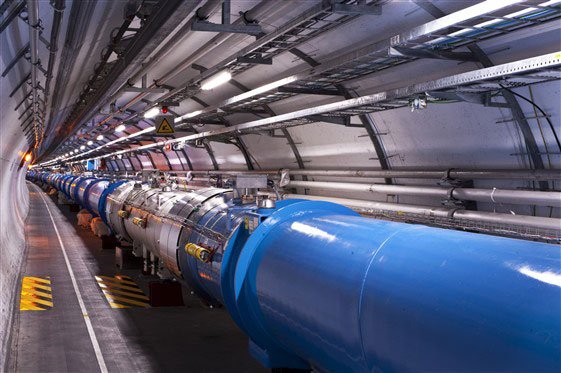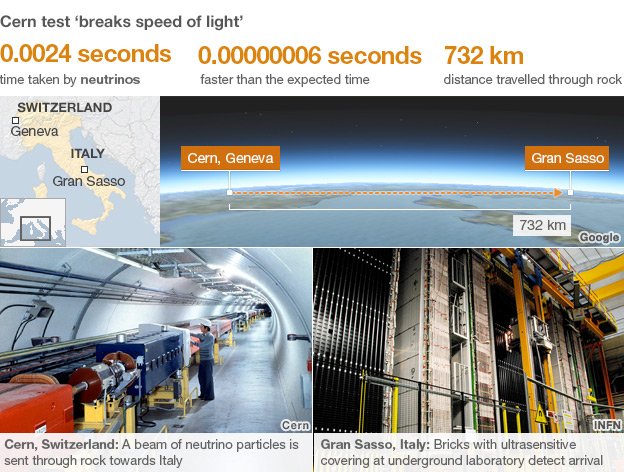A major upgrade for the Large Hadron Collider (LHC), which is already known for its cutting-edge science, has begun.
Engineers work should double the energy of the LHC, already the most powerful particle accelerator in the world.
Scientists believe the upgrade will enable them to discover new particles which will lead to a more complete theory of how the Universe works.

Scientists believe the LHC upgrade will enable them to discover new particles which will lead to a more complete theory of how the Universe works
The engineers’ tasks also include testing and replacing some of the LHC’s main dipole and quadrupole magnets, which are used to bend the paths of the particles and keep them tightly bunched; conducting tests to detect any irregularities in the magnets or imperfections in the electrical insulation; and a range of other work to improve the machine.
The LHC upgrade will enable it to discover new particles leading to a radical change in our understanding of how the Universe works.
The discovery of Higgs particle last year was the end of a successful chapter of late 20th Century physics.
This was the development of the current theory in the 1960s and 70s called the “Standard Model”.
This theory says that most of the forces of nature, the objects around us and our own existence, are all down to the interaction of the Higgs with 16 other particles. It successfully explains how electricity, magnetism and light operate.
Since then, all the particles predicted by the Standard Model have been discovered – including most recently the Higgs.
The problem though is scientists known this theory is limited. It explains extremely well the world around us, but it cannot explain the way most of the Universe behaves.
Physicists hope that by operating at full power, the LHC will be able to find evidence of so-called supersymmetric particles. These are like the particles in the Standard Model – but more massive.
One form of supersymmetry predicts that there should be five Higgs bosons, which are each slightly different.
[youtube Xe78DJJNQBQ]
Particle accelerator Large Hadron Collider (LHC) has turned off its particle beams ahead of a shut-down period that will last two years.
The LHC is best known for its role in spotting the Higgs boson in late 2012.
But following technical faults shortly after it first switched on, the machine has never been run at the full energies for which it was designed.
A programme of repairs and upgrades should allow that in late 2014.
The LHC’s beams were “dumped” early on Thursday morning, but it will take until Saturday morning for the machine’s 1,734 magnets to warm up to room temperature.
Then an unprecedented period of upgrade and repair – dubbed “Long Shutdown 1” – will begin.
The machine ran at particle energies of 8 trillion electron-volts (TeV) in 2012, up from the prior high point of 7TeV in 2011. But when the shutdown concludes, slated for the end of November 2014, it should be set to run at 13TeV – far and away the highest-energy collisions ever attempted by scientists.

The LHC is best known for its role in spotting the Higgs boson in late 2012
The major work required is to upgrade the connections between the magnets, such that they can handle the enormous electrical currents that may pass through them at higher particle energies and in the event of faults such as the one in 2008.
But the shutdown maintenance schedule also includes upgrades to all four of the LHC’s detectors, the shielding of electronics – even the ventilation system of the 27 km-long tunnel that houses the main accelerator ring.
The shutdown is due to conclude in late November 2014, after which the system will be put through its paces and experiments are expected to resume in February or March 2015.
Faster-than-light neutrinos experiment that might have been the biggest physics story of the past century may instead be down to a faulty connection.
In September 2011, the OPERA experiment reported it had seen particles called neutrinos evidently travelling faster than the speed of light.
The team has now found two problems that may have affected their test in opposing ways: one in its timing gear and one in an optical fibre connection.
More tests from May will determine just how they affect measured speeds.
The OPERA collaboration (an acronym for Oscillation Project with Emulsion-Racking Apparatus) was initially started to study the tiny particles as they travelled through 730km of rock between a particle accelerator at the European Organization for Nuclear Research (CERN) in Switzerland and the Gran Sasso underground laboratory in Italy.
Its goal was to quantify how often the neutrinos change from one type to another on the journey.
But during the course of the experiments the team found that the neutrinos showed up 60 billionths of a second faster than light would have done over the same distance – a result that runs counter to a century’s worth of theoretical and experimental physics.
The team submitted the surprising result to the scientific community in an effort to confirm or refute it, and several other experiments around the world are currently working to replicate the result.

Faster-than-light neutrinos experiment that might have been the biggest physics story of the past century may instead be down to a faulty connection
A repeat of the experiment by the OPERA team will now address whether the issues they have found affect the ultimate neutrino speed they measure.
The two problems the team has identified would have opposing effects on the apparent speed.
On the one hand, the team said there is a problem in the “oscillator” that provides a ticking clock to the experiment in the intervals between the synchronizations of GPS equipment.
This is used to provide start and stop times for the measurement as well as precise distance information.
That problem would increase the measured time of the neutrinos’ flight, in turn reducing the surprising faster-than-light effect.
But the team also said they found a problem in the optical fibre connection between the GPS signal and the experiment’s main clock.
In contrast, the team said that effect would increase the neutrinos’ apparent speed.
Only repeats of the experiments by OPERA and other teams will put the matter to rest.
“These latest developments show how hard the OPERA team is working to understand the results,” said Dave Wark, a particle physicist from the Rutherford Appleton Laboratory in the UK and committee member of Japan’s principal neutrino facility T2K.
“Just as it would have been unwise to jump to the conclusion that the initial results were the result of an anomaly, it would be unwise to make any assumptions now. It is the nature of science that theories have to be tested, re-tested and then tested again”.
In a statement, the OPERA collaboration said: “While continuing our investigations, in order to unambiguously quantify the effect on the observed result, the collaboration is looking forward to performing a new measurement of the neutrino velocity as soon as a new bunched beam will be available in 2012.”
Meanwhile, the Borexino and Icarus experiments, also at Gran Sasso, the Minos experiment based at the US Fermilab, and Japan’s T2K facility are all working on their own neutrino speed measurements, with results expected in the next few months.



